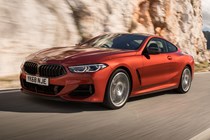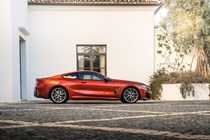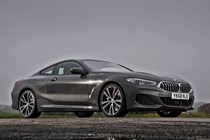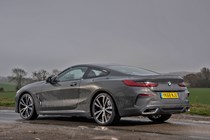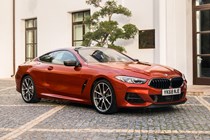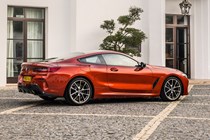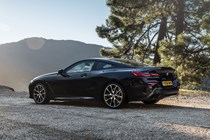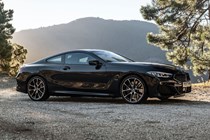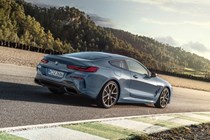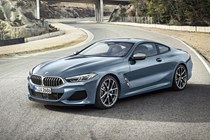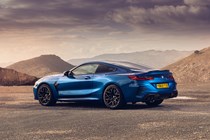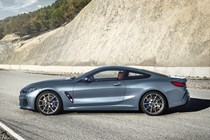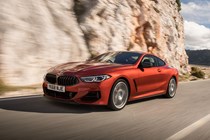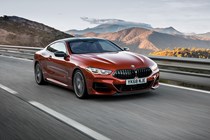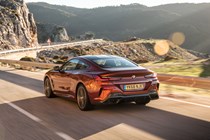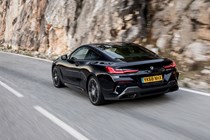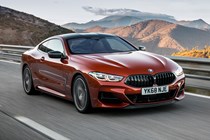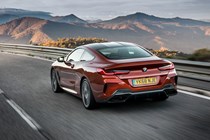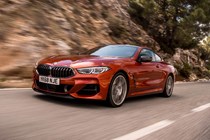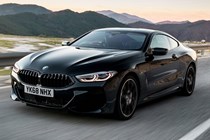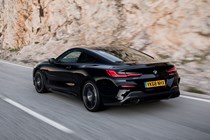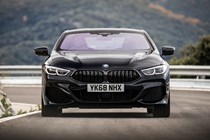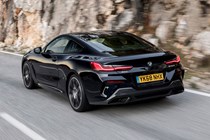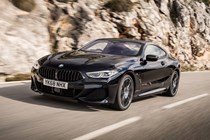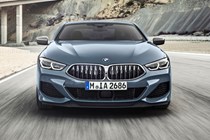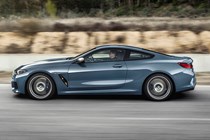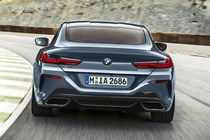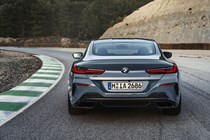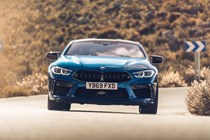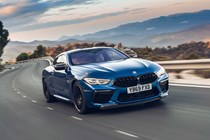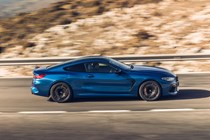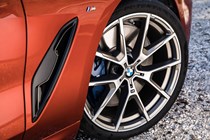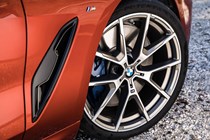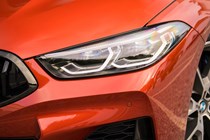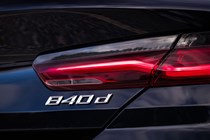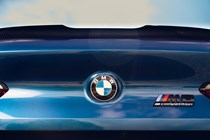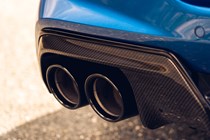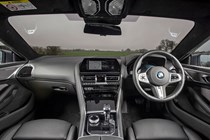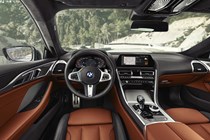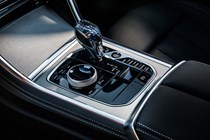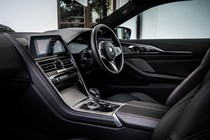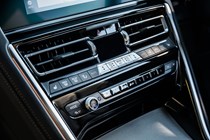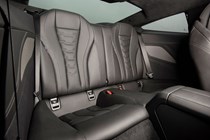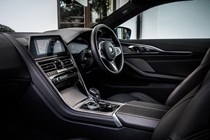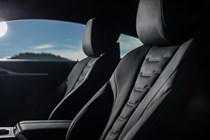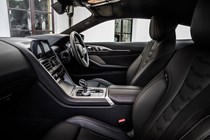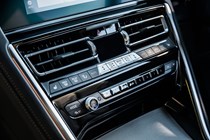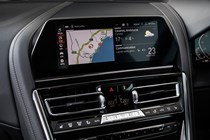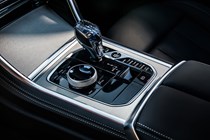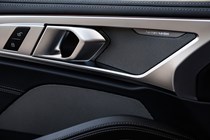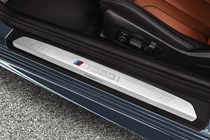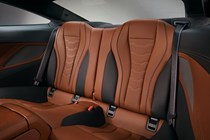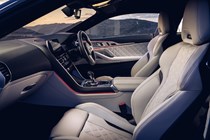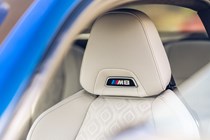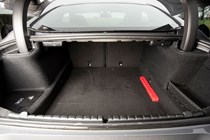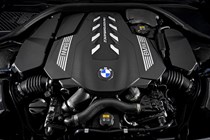
BMW 8-Series engines, drive and performance
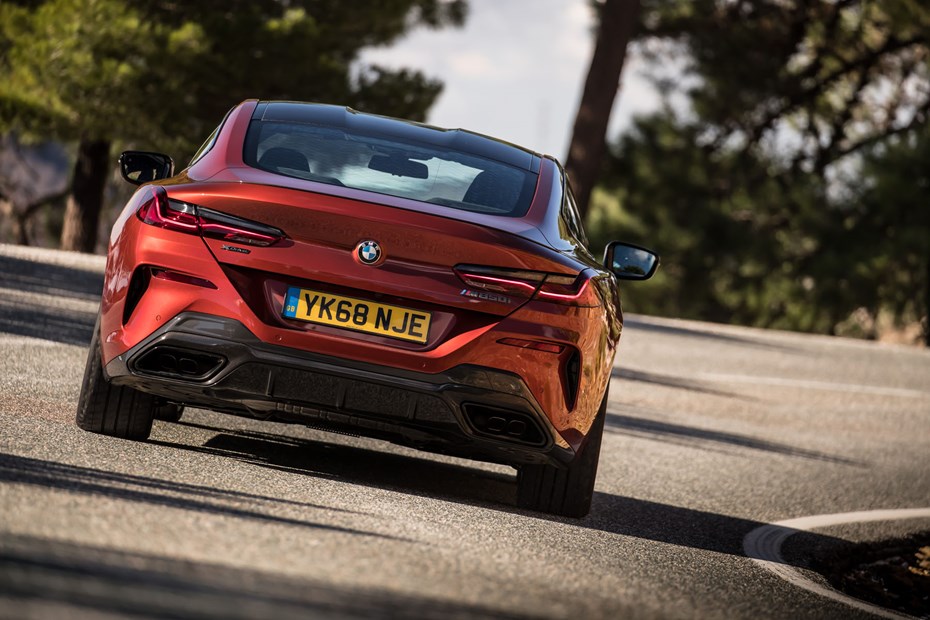
- Two petrols and a diesel
- Plus a blistering M8 Competition
- Performance strong for all models
The 8 Series features a range of powerful engines, so you won’t feel short-changed by any of them. Even the entry-level models could hardly be called entry-level.
Two petrols are available in the main range – an 840i and M850i xDrive. The former uses a 3.0-litre six-cylinder engine producing 340hp and 500Nm of torque. This all helps get the 0 to 62mph from a standstill in 5.0 seconds. It’s the only 8 Series with rear-wheel drive, but still uses the same eight-speed automatic transmission.
If you want more power from your petrol, there’s the M850i xDrive, a halfway house to the full-fat M8 Competition. It uses a 4.4-litre V8 producing 530hp and a whopping 750Nm of torque. 0-62mph takes just 3.7 seconds.
BMW told us it was a prerequisite for the 8 Series to feature an engine with its own character, rather than just a recycled existing V8 found in the M550i in other markets. That means it gains 68hp and 100Nm of torque over the M550i and crucially that latter figure is available from 1,800rpm, for effortless acceleration – something of a grand tourer necessity.
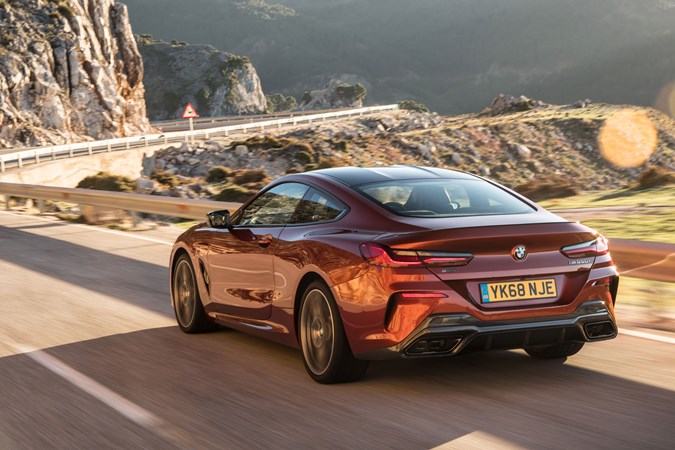
Thing is, that’s the same torque offering you get in an M5, which also uses a derivation of this 4.4-litre V8. So why not use that engine instead? Well, BMW’s powertrain engineers said the M5 was too aggressive in its delivery, and with 600hp, left little room above the M850i for the full-fat M8 that arrived further down the line.
It’s entirely as potent as you would imagine a twin-turbocharged 4.4-litre V8 to be. The M850i thunders into life, then rumbles and burbles around at low speed with all the muted menace of distant artillery fire. Standard-fit all-wheel drive gives the 8 Series impressive traction.
On the road it proves to be flexible and forceful in equal measure. The straight-line performance is a given, but the way it pulls from virtually zero revs is the real selling point – breathtaking, effortless acceleration is never far away, and the well of reserve power feels as deep as the bellow from the exhaust, complete with the now trademark crackles and bangs on the overrun.
Helping to manage all of this is a redesigned eight-speed automatic gearbox, strengthened to help deal with the increase in torque, and tuned to deliver faster shifts. It’s also cleverly linked to the brake pedal – scrub off speed gradually and the ’box will shift down accordingly. Stand on the brakes in anticipation of a tight turn and it’ll cascade down the gears, keeping the revs above 4,500rpm for a speedy getaway. You occasionally still have a delay between putting your foot down and having the transmission deliver its power onto the road though, especially from a standstill.
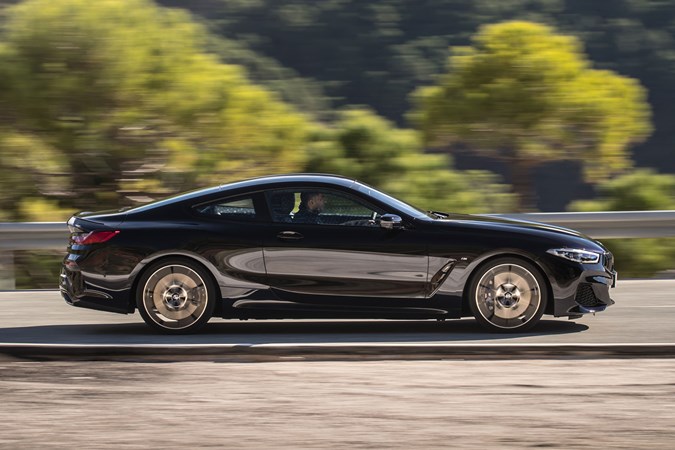 One diesel option available
One diesel option available
If you need a more sensible option, there’s an 840d xDrive comes with a 3.0-litre straight-six that blends performance with more impressive efficiency. With 320hp and 680Nm of torque, the 840d is hardly a slouch, surging forwards effortlessly and with a very pleasant and un-diesel-like hum from the engine. Again, this is an all-wheel drive model and it’s a surprisingly rapid addition to the range, managing a 0-62mph time of 4.9 seconds.
Fiddling with the driving modes tweaks just how responsive it is, but even in Comfort there’s very little effort required to get going – the torquey makes for a fantastic car to cruise along in and suits the 8 Series extremely well.
BMW M8 offers upgraded engine
The BMW M8 Competition uses an upgraded setup to the M850i. It’s powered using a developed version of the 4.4-litre V8 engine under the bonnet – albeit in a sportier guise – codenamed S63, rather than N63.
This means you get upgraded cooling systems and oil supply, as well as a high-pressure injection system. In short, this results in a power upgrade to 625hp, although the torque figure of 750Nm remains the same. The 0-62mph time drops down to 3.2 seconds and top speed remains the same at 155mph – although if you opt for the M Driver’s Package, this rises to 190mph.
It’s still four-wheel drive but, just like the M5 saloon, the option to send power solely to the rear wheels is available, changing the character of the vehicle dramatically.
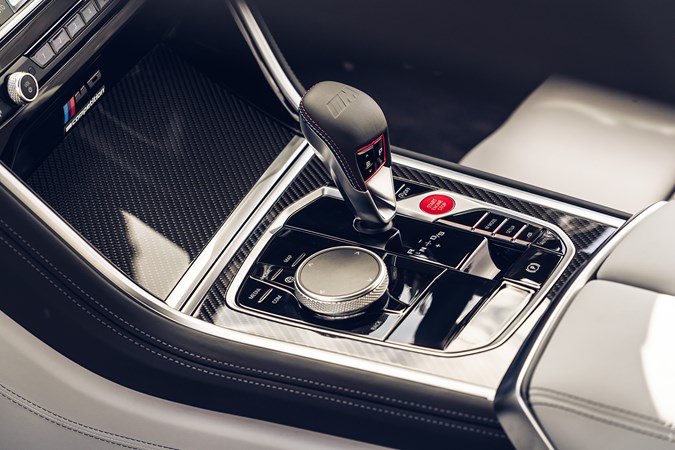
The automatic gearbox on the M8 Competition is a joy to use during spirited driving when using the steering wheel-mounted paddles and is particularly smooth , unlike the rev limiter which, like the M850i, cuts the power abruptly.
The toggle switch on the gearlever also allows you to change the ferocity of the gearchanges, with a Comfort setting to offer a more relaxed driving experience when you’re in the mood to progress a little more slowly to your destination.
How does it handle?
- Driving modes really tweak the experience
- Comfort makes it a wafty cruiser
- Sport makes it feel sharp and agile
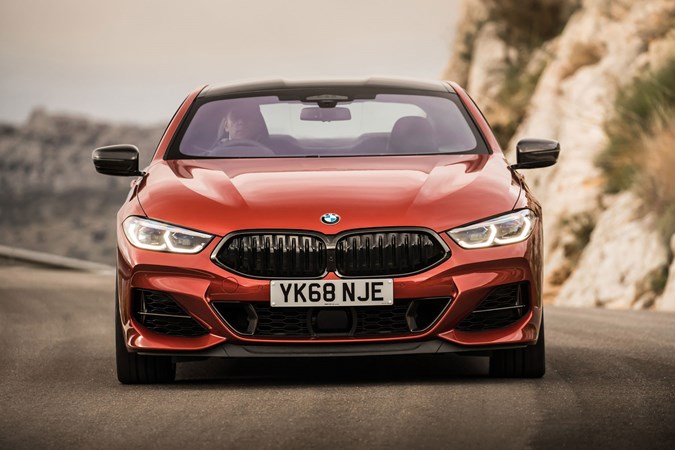
At first the overwhelming sensation is size – this is a wide car. Good news, then, that the steering is direct, nicely weighted and inspires confidence in the way it dials out small corrections from just off the straight-ahead position.
The wheel itself feels at first like a standard BMW item – as thick as a bike inner tube and almost as squashy – but this time around the amount of padding has been cut down, so the rim itself is much firmer. This improves feel, says BMW’s engineers, reducing the latency between your fingertips and the road surface.
We start off in Comfort mode, which sets the chassis, drivetrain, steering weight and exhaust sound to its most refined and quiet set-up whichever model you’re in. Ramp up through the Sport and Sport+ modes and things quickly become more aggressive, but in an unintimidating way.
Confidence grows thanks to the surprising agility added by the optional rear-wheel steer system, which helps you make tighter turns in town and adds stability in high-speed corners. It can feel a little odd in roundabouts at first, but you quickly grow used to it. The optional M Suspension Professional with Active Roll Stabilisation endows the 8 Series with superb body control too, again helping it feel like a smaller car and increasing the keenness to turn in and carry speed. Unlike a similar system in the Mercedes-Benz S-Class, you can’t feel this working in the 8 Series. It just does.
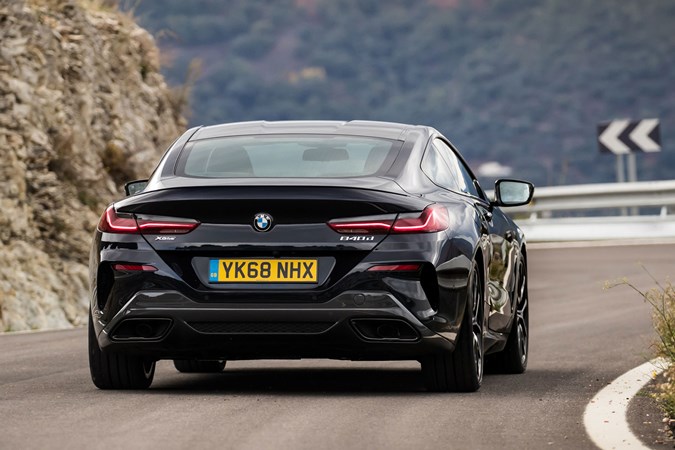
We’ve also tested the M850i on a circuit, where it could have wilted under the rigours of track driving but coped impressively well for such a large, heavy car. Its giant steel brakes remained strong throughout, and it’s a fun, fast and safe car to drive quickly.
The 8 Series features a range of powerful engines, so you won’t feel short-changed by any of them. Even the entry-level models could hardly be called entry-level.
Two petrols are available in the main range – an 840i and M850i xDrive. The former uses a 3.0-litre six-cylinder engine producing 340hp and 500Nm of torque. This all helps get the 0 to 62mph from a standstill in 5.0 seconds. It’s the only 8 Series with rear-wheel drive, but still uses the same eight-speed automatic transmission.
If you want more power from your petrol, there’s the M850i xDrive, a halfway house to the full-fat M8 Competition. It uses a 4.4-litre V8 producing 530hp and a whopping 750Nm of torque. 0-62mph takes just 3.7 seconds.
BMW M8 offers both four- and rear-wheel drive handling at the push of a button
The steering on the M8 Competition will be familiar to those experienced with BMWs – it’s responsive, linear and helps this large coupe feel incredibly easy to pilot.
Some may find the sharpness a little slow off-centre sometimes – but we suspect this is more related to the rear-wheel steering system activating and tightening up the line as you apply more lock.
Thankfully, the steering doesn’t suffer too much from the artificially-heavy weighting that blights some other BMWs in the sportier drive modes, and it’s easy to build a rhythm down an entertaining stretch of road.
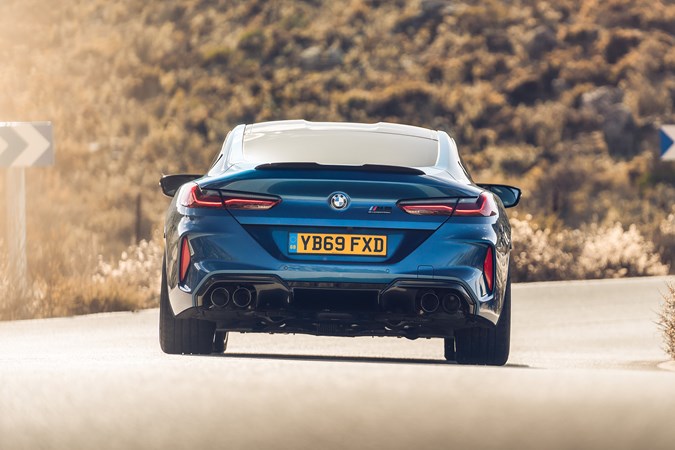
Fundamentally, it’s a sharper driving experience with less body roll than rivals with a higher focus on luxury, such as the Bentley Continental GT and Mercedes-Benz S-Class Coupe.
The handling is still sharp enough when set in its most docile Economy and Comfort modes and while that’s not necessarily what certain luxury buyers want, die-hard BMW fans will appreciate the sporting side to it.
Handling characteristics heavily dependent on drive mode
There are a multitude of settings to alter in the BMW M8 Competition, which gives owners a high level of configuration to reach their desired, if specific, setting. How much time owners will actually spend cycling through each sub-parameter is difficult to tell, but you can simply cycle through Eco, Comfort, Sport, Sport Plus and Track modes to automatically adjust throttle sharpness, steering weight, suspension firmness and the loudness of the exhaust for you.
Switching to Sport mode is, frankly, horrid, as the M8 Competition doesn’t really feel comfortable in this mode as the engine sounds like it’s being strangled and feels reluctant to pick up any pace. Imagine a toddler restrained in a child seat against their will and this is what this mode feels like it’s doing to the car.
Thankfully, the sharp steering remains unaltered, but you need to go one further and into Sport Plus for the engine and chassis to wake up and feel as alert as it should.
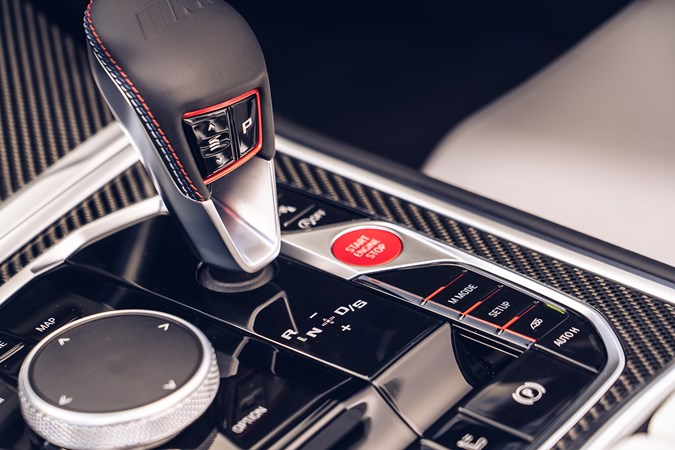
There are three settings for the drivetrain as well. The default all-wheel drive mode actively shuffles the power from the front wheels to the back efficiently, and you can feel the power being trimmed from the front just as it begins to understeer and wash wide.
The system certainly works, but you can’t help think it’d work even better if the near-two-tonne M8 wasn’t so heavy in the first place.
You can switch to Sport AWD and quell that hint of understeer with ample inputs of the throttle. This certainly ups the level of fun to be had, and it’s not too dissimilar from a Mercedes-AMG E 63 S in character with its slightly rear-biased all-wheel drive system.
This setting is a good middle ground, as you can have some fun here and have the M8 Competition squirm and rotate a little without losing control and feeling terrified.
The rear-wheel drive setting is not recommended for use on public roads, and while that may be deemed useless for most, it at least transforms the car’s character.
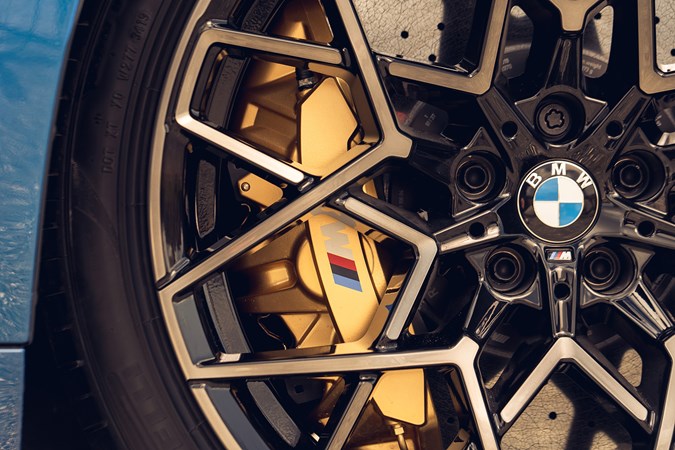
You can also select between two levels of brake pedal pressure, to make it feel more positive under spirited driving conditions, but this doesn’t make any actual different to the maximum amount of stopping power available.
BMW M8 offers both four- and rear-wheel drive handling at the push of a button
The steering on the M8 Competition will be familiar to those experienced with BMWs – it’s responsive, linear and helps this large coupe feel incredibly easy to pilot.
Some may find the sharpness a little slow off-centre sometimes – but we suspect this is more related to the rear-wheel steering system activating and tightening up the line as you apply more lock.
Thankfully, the steering doesn’t suffer too much from the artificially-heavy weighting that blights some other BMWs in the sportier drive modes, and it’s easy to build a rhythm down an entertaining stretch of road.

Fundamentally, it’s a sharper driving experience with less body roll than rivals with a higher focus on luxury, such as the Bentley Continental GT and Mercedes-Benz S-Class Coupe.
The handling is still sharp enough when set in its most docile Economy and Comfort modes and while that’s not necessarily what certain luxury buyers want, die-hard BMW fans will appreciate the sporting side to it.
Handling characteristics heavily dependent on drive mode
There are a multitude of settings to alter in the BMW M8 Competition, which gives owners a high level of configuration to reach their desired, if specific, setting. How much time owners will actually spend cycling through each sub-parameter is difficult to tell, but you can simply cycle through Eco, Comfort, Sport, Sport Plus and Track modes to automatically adjust throttle sharpness, steering weight, suspension firmness and the loudness of the exhaust for you.
Switching to Sport mode is, frankly, horrid, as the M8 Competition doesn’t really feel comfortable in this mode as the engine sounds like it’s being strangled and feels reluctant to pick up any pace. Imagine a toddler restrained in a child seat against their will and this is what this mode feels like it’s doing to the car.
Thankfully, the sharp steering remains unaltered, but you need to go one further and into Sport Plus for the engine and chassis to wake up and feel as alert as it should.

There are three settings for the drivetrain as well. The default all-wheel drive mode actively shuffles the power from the front wheels to the back efficiently, and you can feel the power being trimmed from the front just as it begins to understeer and wash wide.
The system certainly works, but you can’t help think it’d work even better if the near-two-tonne M8 wasn’t so heavy in the first place.
You can switch to Sport AWD and quell that hint of understeer with ample inputs of the throttle. This certainly ups the level of fun to be had, and it’s not too dissimilar from a Mercedes-AMG E 63 S in character with its slightly rear-biased all-wheel drive system.
This setting is a good middle ground, as you can have some fun here and have the M8 Competition squirm and rotate a little without losing control and feeling terrified.
The rear-wheel drive setting is not recommended for use on public roads, and while that may be deemed useless for most, it at least transforms the car’s character.

You can also select between two levels of brake pedal pressure, to make it feel more positive under spirited driving conditions, but this doesn’t make any actual different to the maximum amount of stopping power available.


